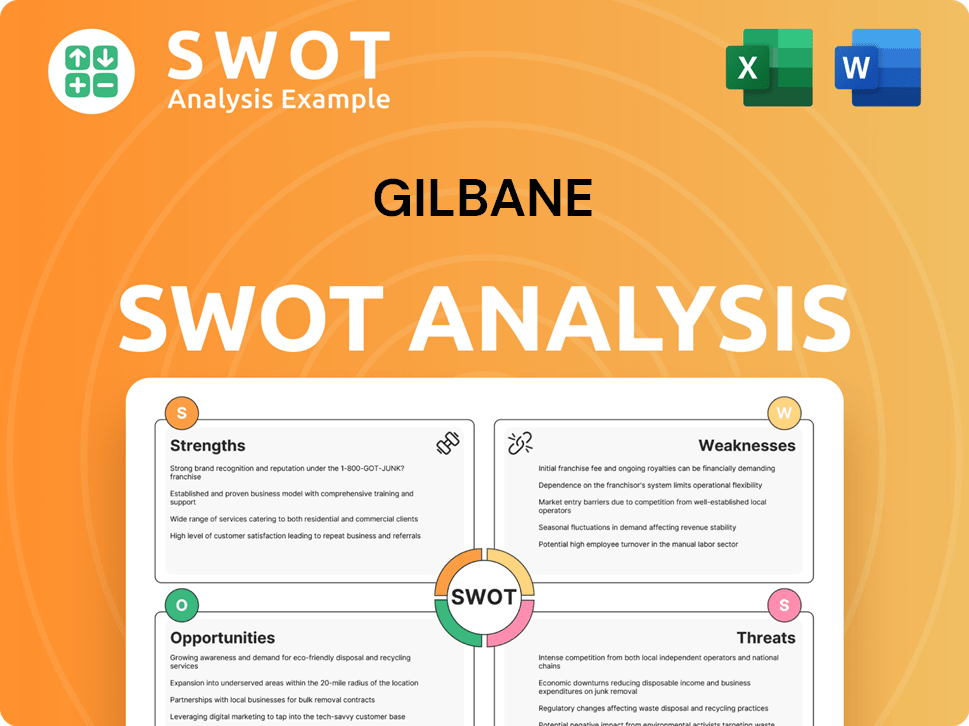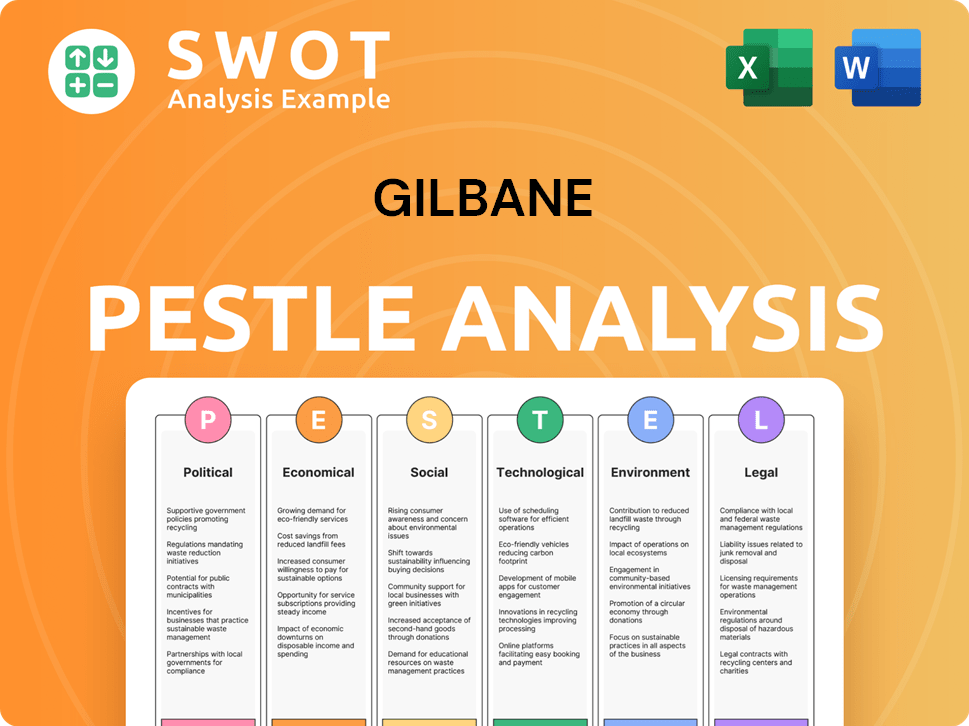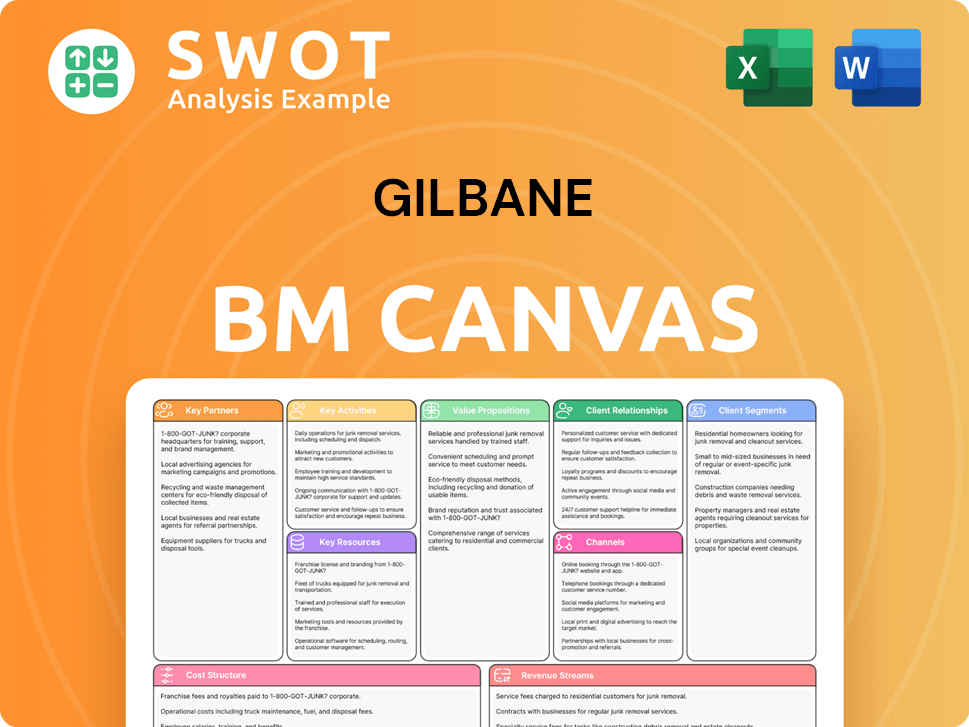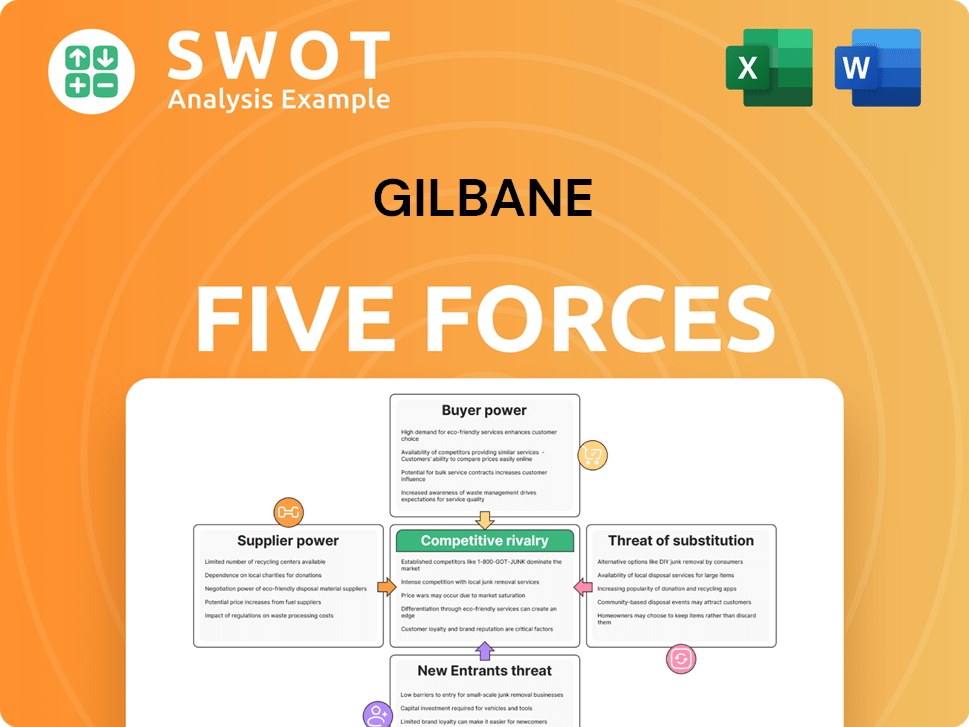Gilbane Bundle
How Does Gilbane Company Navigate the Cutthroat Construction Industry?
The construction industry is undergoing a massive transformation, fueled by technology, sustainability, and evolving client needs. Gilbane Building Company, a global leader since 1870, is at the forefront of this change, shaping skylines and delivering vital infrastructure. Understanding Gilbane's position in this dynamic market is critical for anyone interested in the future of construction.

This analysis provides a deep dive into the Gilbane SWOT Analysis, examining its competitive landscape, key players, and strategic advantages. We'll explore the Construction Market, dissecting Gilbane's market share, and conducting a thorough Competitor Analysis to understand its position relative to rivals like Turner Construction and Skanska. This exploration of Gilbane Company Competitive Landscape will illuminate its strengths, weaknesses, and growth strategy within the complex construction industry competitive dynamics.
Where Does Gilbane’ Stand in the Current Market?
Gilbane Building Company holds a strong market position within the construction and facilities services sector. Although specific market share details for private entities like Gilbane are not publicly available, industry rankings consistently place the company among the top construction management firms in the United States. For instance, in Engineering News-Record's (ENR) 2024 Top 400 Contractors list, Gilbane is frequently listed within the top 20, reflecting its substantial scale and project volume, which is a key aspect of the Construction Industry Analysis.
The company's core operations include comprehensive construction management, general contracting, design-build, and program management. Gilbane also offers a full suite of facilities-related services, such as pre-construction planning, integrated consulting, and facility activation. This diversification allows the company to serve a broad range of clients and projects, solidifying its position in the Construction Market.
Geographically, Gilbane has a strong presence across the United States, with numerous regional offices, and extends its reach internationally, serving diverse markets. Its customer segments are broad, encompassing public and private entities in education, healthcare, government, commercial, and industrial sectors. Over time, Gilbane has strategically shifted its positioning to emphasize integrated project delivery and advanced technological solutions, including building information modeling (BIM) and virtual design and construction (VDC), reflecting a move towards higher-value, technology-driven services. If you want to know more about the target market of Gilbane, read this article about Target Market of Gilbane.
While specific market share figures are not publicly disclosed, Gilbane consistently ranks among the top construction management firms. ENR's 2024 Top 400 Contractors list frequently places Gilbane within the top 20, indicating significant market presence.
Gilbane offers a comprehensive suite of services, including construction management, general contracting, design-build, and program management. Facilities-related services, such as pre-construction planning and integrated consulting, are also part of their offerings.
Gilbane has a strong presence across the United States with numerous regional offices. It also extends its reach internationally, serving diverse markets. This wide geographic coverage supports its ability to secure projects across different regions.
The company serves a broad range of customer segments, including public and private entities. These include education, healthcare, government, commercial, and industrial sectors. This diversification helps in mitigating risks.
Gilbane's strengths include a diversified service portfolio, a strong geographic presence, and a broad customer base. The company's focus on integrated project delivery and advanced technological solutions further enhances its market position. These factors contribute to Gilbane's ability to compete effectively in the Gilbane Company Competitive Landscape.
- Strong Financial Health: Gilbane's financial performance is robust, supported by a consistent pipeline of large-scale projects.
- Sector Expertise: Gilbane holds a particularly strong position in the education and healthcare sectors.
- Technological Advancement: Implementation of BIM and VDC technologies enhances project efficiency and client satisfaction.
- Client Satisfaction: Gilbane often exceeds industry averages in terms of project complexity and client satisfaction.
Gilbane SWOT Analysis
- Complete SWOT Breakdown
- Fully Customizable
- Editable in Excel & Word
- Professional Formatting
- Investor-Ready Format

Who Are the Main Competitors Challenging Gilbane?
The Growth Strategy of Gilbane faces a dynamic competitive landscape within the construction industry. This landscape is shaped by a mix of direct and indirect competitors, all vying for market share in a sector that is constantly evolving. Understanding these competitive pressures is crucial for assessing Gilbane's market position and future prospects.
The construction market is characterized by intense competition, requiring firms to continuously adapt their strategies. This includes focusing on project efficiency, technological advancements, and client relationships to maintain a competitive edge. The industry's cyclical nature, influenced by economic conditions and infrastructure spending, further complicates the competitive dynamics.
Gilbane Building Company operates within a highly competitive global construction market, facing strong direct and indirect competition from a range of firms. Its most significant direct competitors include other large, diversified general contractors and construction management firms.
Direct competitors are those that offer similar services and compete for the same projects. These companies often have extensive experience in large-scale infrastructure and government projects.
Bechtel is a global engineering, procurement, and construction company. It competes with Gilbane on large-scale infrastructure and government projects. Bechtel's extensive experience in complex, multi-billion dollar endeavors makes it a significant rival.
Fluor Corporation offers similar EPC and construction management services. It particularly challenges Gilbane in the industrial and energy sectors. Fluor's global presence and diverse project portfolio make it a key competitor.
Turner Construction Company is a direct competitor across many of Gilbane's core markets. This includes commercial, healthcare, and education. It often vies for the same high-profile projects. Turner is a subsidiary of HOCHTIEF.
Skanska AB is a Swedish multinational construction and development company. It competes strongly in building construction and infrastructure projects, particularly in urban development and public-private partnerships. Skanska's focus on sustainable practices is a key differentiator.
Clark Construction Group is a major U.S. general contractor. It frequently competes with Gilbane for large federal and commercial contracts. Clark's strong presence in the U.S. market makes it a formidable competitor.
These competitors challenge Gilbane through competitive pricing, extensive global networks, specialized expertise in niche markets, and strong client relationships. For example, in 2024, the construction market saw significant growth in infrastructure spending, increasing the competition for projects among these firms. The ability to secure large contracts and maintain profitability in a competitive environment is a key factor in assessing each company's performance.
Indirect competition arises from specialized consulting firms, architectural and engineering companies offering project management services, and even in-house construction departments of large corporations. The industry also sees emerging players focusing on modular construction, sustainable building practices, and advanced construction technologies, which could disrupt traditional competitive dynamics.
- Specialized Consulting Firms: Offer project management services, competing for specific aspects of projects.
- Architectural and Engineering Companies: Provide design and project management, often competing with general contractors.
- In-House Construction Departments: Large corporations with their own construction teams.
- Modular Construction Companies: Focus on prefabrication and off-site construction, gaining traction in various markets.
- Sustainable Building Practices: Companies specializing in green building and sustainable construction.
- Advanced Construction Technologies: Firms utilizing Building Information Modeling (BIM), and other technologies.
Gilbane PESTLE Analysis
- Covers All 6 PESTLE Categories
- No Research Needed – Save Hours of Work
- Built by Experts, Trusted by Consultants
- Instant Download, Ready to Use
- 100% Editable, Fully Customizable

What Gives Gilbane a Competitive Edge Over Its Rivals?
Understanding the competitive landscape of the Gilbane Building Company requires a deep dive into its core strengths and strategic positioning within the construction industry. The company, with a history spanning over a century, has cultivated a strong reputation, which is a key factor in maintaining its competitive edge. This reputation is built on a foundation of quality, reliability, and client satisfaction, fostering strong client loyalty and repeat business. This is particularly crucial in the construction market, where relationships are often the cornerstone of success.
Gilbane's competitive advantages are multifaceted, extending beyond mere project execution to encompass technological innovation, financial stability, and a client-focused culture. The company's commitment to adopting advanced construction technologies, such as Building Information Modeling (BIM) and Virtual Design and Construction (VDC), enhances project delivery efficiency and reduces costs. Furthermore, Gilbane’s robust financial health and extensive bonding capacity enable it to undertake large-scale, complex projects, setting it apart from smaller competitors. These factors collectively contribute to Gilbane's sustained success in a dynamic industry.
A comprehensive construction industry analysis reveals that Gilbane's ability to navigate complexities and deliver projects on time and within budget is a significant differentiator. The company's deep-rooted experience across various sectors, including healthcare and mission-critical facilities, provides a wealth of institutional knowledge. This expertise allows Gilbane to confidently tackle complex projects. In a market where competition is fierce, Gilbane's strategic approach to innovation, financial management, and client relationships positions it favorably for continued growth. For more on their strategic vision, explore the Growth Strategy of Gilbane.
Gilbane's strong brand reputation and client loyalty are significant competitive advantages. This allows for repeat business and builds trust within the construction market. The company's long-standing history has solidified its position as a reliable partner.
Gilbane's early adoption of advanced construction technologies, like BIM and VDC, improves project delivery. These technologies reduce errors, enhance project timelines, and lead to cost efficiencies. This commitment to innovation sets them apart.
Gilbane's robust financial health allows it to undertake large-scale projects. This financial stability is a barrier to entry for smaller firms. Strong bonding capacity ensures project security and client confidence.
The company's experienced workforce and expertise across various sectors, including healthcare and mission-critical facilities, are crucial. This expertise allows them to handle complex projects with confidence. Gilbane's skilled team drives project excellence.
Gilbane's competitive advantages are multifaceted, contributing to its strong market position and ability to secure and execute large-scale projects. These advantages include a strong reputation, technological innovation, and financial stability.
- Reputation and Trust: Gilbane's long-standing reputation for quality and reliability fosters client loyalty.
- Technological Leadership: Early adoption of BIM and VDC enhances project efficiency and reduces costs.
- Financial Strength: Robust financial health and bonding capacity enable large-scale project undertakings.
- Sector Expertise: Deep experience in specialized areas like healthcare and mission-critical facilities.
Gilbane Business Model Canvas
- Complete 9-Block Business Model Canvas
- Effortlessly Communicate Your Business Strategy
- Investor-Ready BMC Format
- 100% Editable and Customizable
- Clear and Structured Layout

What Industry Trends Are Reshaping Gilbane’s Competitive Landscape?
Understanding the competitive landscape of Gilbane Building Company requires a deep dive into industry trends, future challenges, and emerging opportunities. The Brief History of Gilbane provides a foundation for assessing its current position. This analysis considers the impact of technological advancements, sustainability demands, supply chain dynamics, and workforce challenges on Gilbane's strategic outlook within the Construction Industry Analysis.
The construction sector is experiencing significant transformation. Gilbane's ability to adapt to these changes will be crucial for maintaining and enhancing its market share. This involves strategic investments in technology, a focus on sustainable building practices, and proactive risk management to navigate potential disruptions.
The construction industry is evolving rapidly, primarily driven by technological advancements. The adoption of AI, machine learning, robotics, and advanced analytics is increasing. Sustainability and green building practices are becoming more important, driven by regulatory pressures and client demands.
Supply chain disruptions pose a significant threat, leading to material shortages and price volatility. The shortage of skilled labor in the construction sector is escalating, which could impact project timelines and costs. Regulatory changes concerning environmental standards and building codes require continuous adaptation and compliance.
Emerging markets, especially in developing economies, offer substantial growth opportunities. The increasing demand for resilient infrastructure, capable of withstanding climate change impacts, presents a significant opportunity. Aging infrastructure in developed nations necessitates extensive renovation and upgrade projects.
Gilbane should focus on embracing technological advancements to improve efficiency, safety, and project outcomes. Leverage expertise in sustainable construction for market expansion. Develop robust procurement strategies and diversified supplier networks. Invest in workforce development and explore innovative construction methods.
The Construction Market is highly competitive, with significant players vying for market share. Gilbane's ability to navigate these dynamics will determine its future success. Key factors include project portfolio analysis, geographic presence, and client relationships.
- Market Share: The top 50 contractors in the U.S. generated over $490 billion in revenue in 2023.
- Geographic Presence: Expansion into emerging markets, particularly in Asia-Pacific, offers significant growth potential.
- Key Clients: Strong relationships with major clients in healthcare, education, and government sectors are critical.
- Technology Adoption: Implementing AI and machine learning for project management and risk assessment is becoming standard.
Gilbane Porter's Five Forces Analysis
- Covers All 5 Competitive Forces in Detail
- Structured for Consultants, Students, and Founders
- 100% Editable in Microsoft Word & Excel
- Instant Digital Download – Use Immediately
- Compatible with Mac & PC – Fully Unlocked

Related Blogs
- What are Mission Vision & Core Values of Gilbane Company?
- What is Growth Strategy and Future Prospects of Gilbane Company?
- How Does Gilbane Company Work?
- What is Sales and Marketing Strategy of Gilbane Company?
- What is Brief History of Gilbane Company?
- Who Owns Gilbane Company?
- What is Customer Demographics and Target Market of Gilbane Company?
Disclaimer
All information, articles, and product details provided on this website are for general informational and educational purposes only. We do not claim any ownership over, nor do we intend to infringe upon, any trademarks, copyrights, logos, brand names, or other intellectual property mentioned or depicted on this site. Such intellectual property remains the property of its respective owners, and any references here are made solely for identification or informational purposes, without implying any affiliation, endorsement, or partnership.
We make no representations or warranties, express or implied, regarding the accuracy, completeness, or suitability of any content or products presented. Nothing on this website should be construed as legal, tax, investment, financial, medical, or other professional advice. In addition, no part of this site—including articles or product references—constitutes a solicitation, recommendation, endorsement, advertisement, or offer to buy or sell any securities, franchises, or other financial instruments, particularly in jurisdictions where such activity would be unlawful.
All content is of a general nature and may not address the specific circumstances of any individual or entity. It is not a substitute for professional advice or services. Any actions you take based on the information provided here are strictly at your own risk. You accept full responsibility for any decisions or outcomes arising from your use of this website and agree to release us from any liability in connection with your use of, or reliance upon, the content or products found herein.